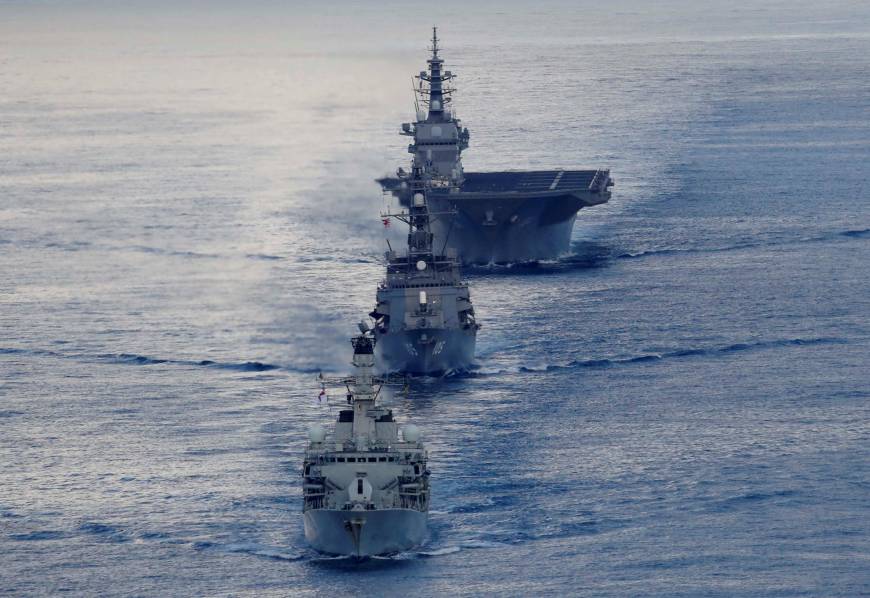Japan conducts naval drill with British Warships
September 28, 2018 | Expert Insights

Tokyo’s largest warship, the Kaga, joined naval drills with Britain’s HMS Argyll in the Indian Ocean before it sailed into the South China Sea.
Background
Japan is the third largest economy in the world by nominal GDP after America and China. It has the fourth largest purchasing power parity. It is also considered the world’s second largest developed economy. After the devastation it was left with at the end of World War II, it has achieved steady and significant growth in the second half of the 20th century. Much of its expansion was due to its highly successful automotive and consumer electronics industries.
China-Japan relations have been considerably better under Shinzo Abe as Prime Minister of Japan since September 2006. However, in the early 2010s, relations deteriorated again, when Japan accused China of withholding its reserves of valuable rare-earth elements. The dispute at the Senkaku/Diaoyu Islands also resulted in several aggressive encounters in the East China Sea. The Senkaku islands were formally claimed by Japan in 1895; however, in the 1970s, China began to reassert its claims over the islands.
The Kaga is a helicopter carrier of the Japanese Maritime Self Defence Force (MSDF) and is Japan’s largest warship. The ship can host up to 28 aircraft, or 14 larger aircraft, 400 troops and 50 3.5-ton trucks (or equivalent equipment). The flight deck has 5 helicopter landing spots that allow simultaneous landings or take-offs. The carrier can also operate the latest stealth F-35 fighter with minimal alterations to its flight deck.
Analysis
Britain, Japan and close ally the United States have found common cause in countering growing Chinese influence in the region, to keep key sea-lanes linking Asia to Europe, the United States and elsewhere from falling under Beijing’s influence.
“We have traditional ties with the British Navy and we are both close U.S. allies and these drills are an opportunity for us to strengthen cooperation,” Kenji Sakaguchi, the Maritime Self Defence Force (MSDF) commander of the Kaga group’s four helicopters said on the hangar deck. The more frequent presence of the Royal Navy is a chance for the two navies to train more closely in the future, he added.
The HMS Argyll, Kaga and its destroyer escort the Inazuma practised formations on calm seas in the Indian Ocean near commercial sea lanes plied by container vessels and oil tankers. Three helicopters from the Japanese carrier hovered above, monitoring the drill.
The Argyll’s arrival comes after Britain’s amphibious assault ship Albion last month challenged Beijing’s territorial claims on its way to Vietnam from Japan, by sailing close to Chinese bases in the Paracel islands in a freedom of navigation operation (FONOP). China dispatched a warship and helicopters to counter the British presence and warned London that similar action in the future could endanger talks for a possible trade deal that Britain is seeking as it prepares to leave the European Union.
In Beijing on Thursday, Defence Ministry spokesman Ren Guoqiang said China was paying close attention to Japan’s activities, and opposed countries from outside the region getting involved in the South China Sea issue.
After crossing the South China Sea, the HMS Argyll will operate in waters around Japan, including a stint of monitoring sanctions imposed on North Korea by the United Nations to force it to abandon nuclear weapons and ballistic missiles. The Argyll is the third Royal Navy ship in Asia’s waters this year, following the tour of the Albion and another frigate.
Counterpoint
As the South China Sea has one of the most active shipping lanes in the world and comprises of multiple international maritime boundaries, naval exercises are frequent. Japan’s participation in this exercise has minimal impact on the stability of the region as Tokyo is yet to perform a freedom of navigation operation (FONOP) in the Senkaku/Diaoyu island chain.
Assessment
Our assessment is that Tokyo has finally started to show its strength in the South China Sea. PM Abe has been boosted by his recent election triumph as well as the North Korea’s reduced hostility to flex Tokyo’s muscles. We believe that Tokyo will send its ships to sail by the disputed Senkaku/Diaoyu islands in the near future, following similar exercises by the US and the UK.








Comments